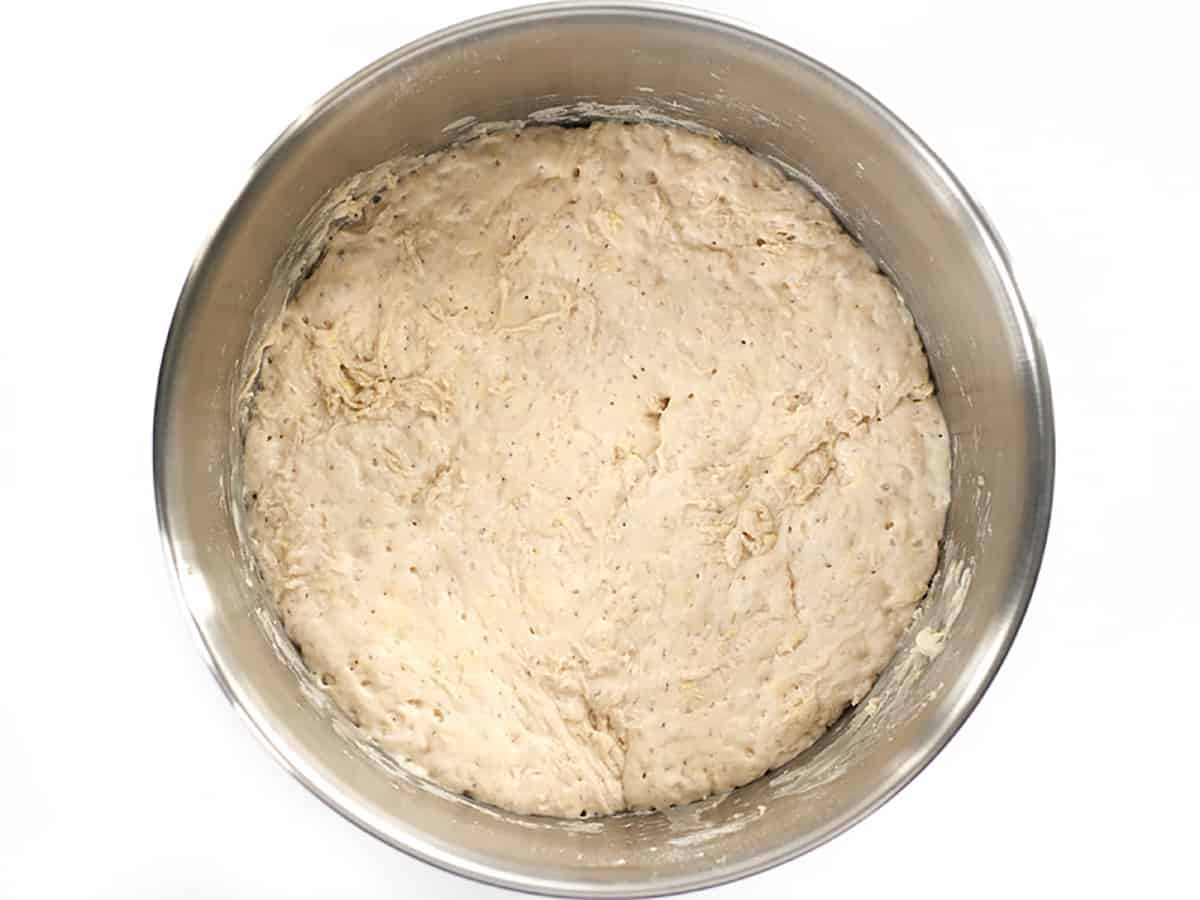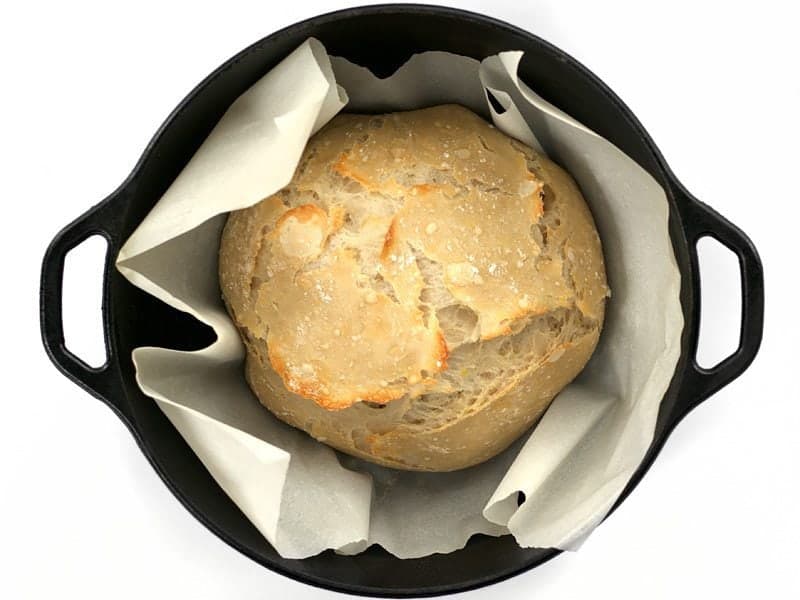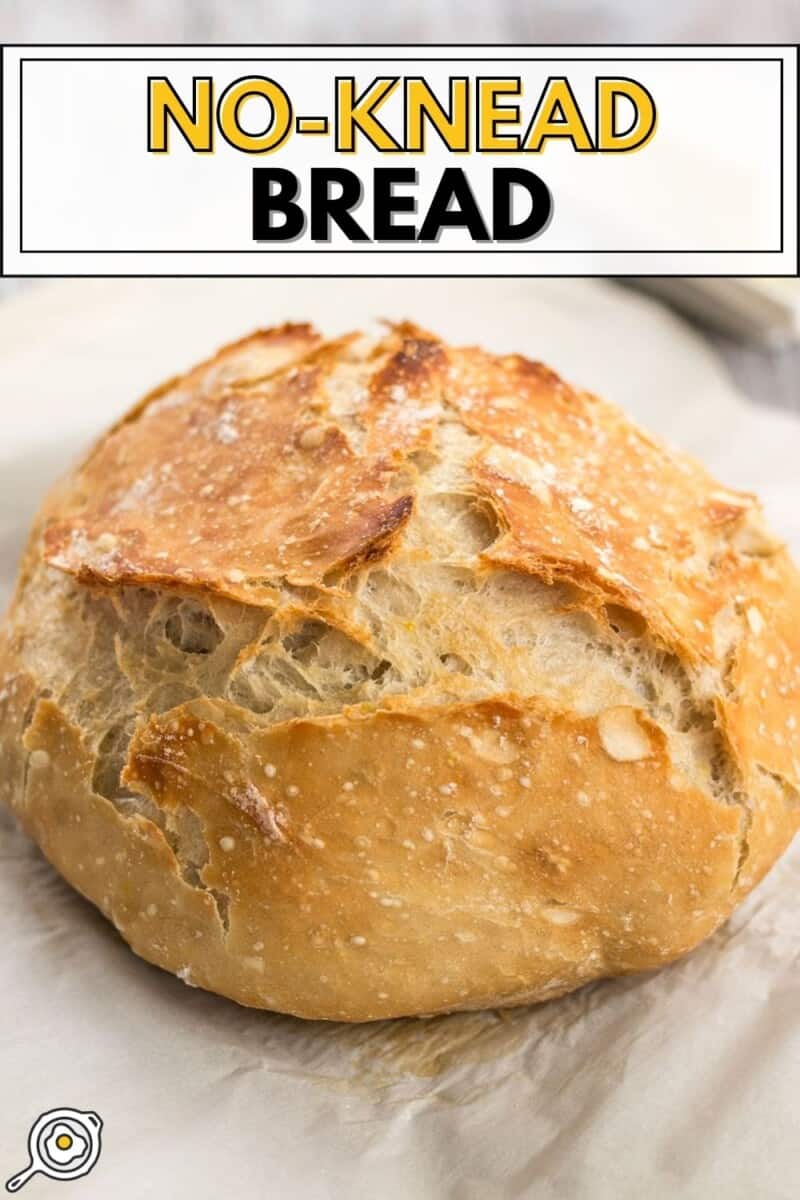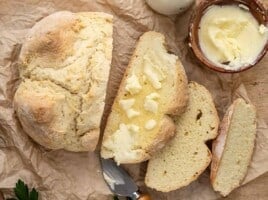I started making no-knead bread in 2010 and it has continued to be my favorite way to make homemade bread because it’s incredibly simple, it doesn’t require a lot of effort, and it makes the most deliciously crusty bakery-style bread ever. To make this no-knead bread recipe you only need four ingredients (including water) and a little bit of time. No fancy equipment or techniques needed!

This post contains some affiliate links, which means that we make a small commission off items you purchase at no additional cost to you.
“I’ve made this twice and it was amazing! Hard to believe something so simple can come together to be something so amazing!”
-Melissa
What Is No Knead Bread?
No-knead bread is an ancient technique for making delicious loaves of bread by utilizing a long fermentation time to develop the gluten the flour instead of hand kneading. Gluten is the protein that gives bread its strength, allowing it to rise into a fluffy loaf, and have that deliciously chewy texture. Kneading bread dough develops gluten quickly, but is quite labor-intensive. If given enough time, yeast can develop the gluten in the dough without the need for manual needing.
Ingredients for No Knead Bread
The best part about this no-knead bread recipe is that it only requires four ingredients, including water, and you still get an incredibly flavorful bread. Here’s all you’ll need to make your own homemade no-knead bread:
- Flour: Our version of no-knead bread was developed using all-purpose flour because that is what we most commonly have on hand. That being said, using bread flour will create even better results. Just keep in mind that bread flour tends to absorb more water than all-purpose flour, so you may need to adjust the ratios slightly.
- Yeast: For this type of bread, we use instant yeast or bread machine yeast, both of which do not need to be activated first by proofing in warm water. You can simply add them to your dry ingredients and go!
- Salt: Without the proper amount of salt, homemade bread will have no flavor, so it’s imperative that you do not skip the salt.
- Water: Water hydrates the flour to create the dough. Because this technique uses a longer ferment time, you can use room-temperature water and you do not have to “wake up” the yeast with warm water. The yeast will have plenty of time to activate as it rests.
What Kind of Yeast to Use
It’s very important to use the correct type of yeast for this recipe. Instant yeast and bread machine yeast are special because they do not require mixing with warm water to “wake up” before adding to a recipe. You can simply stir them into the dry ingredients and they will activate instantly upon hydration, so that is what we use for this super simple no-knead bread technique. Active Dry yeast, on the other hand, needs to be specifically activated in warm water first. If you use active dry yeast in this recipe using the technique below, the bread will likely not rise.
Do I Need to Use a Dutch Oven?
Using a preheated Dutch oven does create the best results because it gives the bread an extra intense boost of heat while retaining all of the moisture and steam. That being said, I have made no-knead bread on a sheet pan with great results! I suggest adding a pan with an inch or so of water on the bottom rack of your oven to create steam if you’re baking your bread on a sheet pan.
If possible, I would suggest investing in a Dutch Oven because they are easily one of the most flexible and useful pieces of cookware. We love our Amazon Basics 6-Quart Enameled Dutch Oven as a very affordable alternative to Le Creuset. Lodge also makes very affordable Enameled Dutch Ovens and plain Cast Iron Dutch Ovens (like the one used in the photos here).
Short Fermentation vs. Long Fermentation
You can make no-knead bread using either a long fermentation (12-18 hours) or a short fermentation (about 2 hours). The difference is that you’ll need more yeast to do the short fermentation and the flavor does not develop quite as deeply. That being said, short fermentation no-knead bread is a great option when you haven’t planned ahead!
Long Fermenation: Follow the instructions below, using ¼ tsp yeast and fermenting the dough for 12-18 hours.
Short Fermentation: Use 2 tsp yeast (or one ¼ oz. packet) and ferment the dough for about 2 hours at room temperature.

No-Knead Bread

Ingredients
- 3 cups all-purpose flour ($0.29)
- 1/4 tsp instant yeast or bread machine yeast* ($0.02)
- 1.5 tsp salt ($0.02)
- 1.5 to 1.75 cup water** ($0.00)
Instructions
- The day before baking, combine the flour, yeast, and salt in a large bowl and stir until they're well combined. Stir in about 1.5 to 1.75 cups room temperature water until a shaggy, sticky ball of dough forms and there is no dry flour left on the bottom of the bowl. The dough should be wet and sticky, but not so wet that it appears glossy. Cover the bowl loosely with plastic and let it sit at room temperature for 12-18 hours.
- The next day, the dough should be fluffy and very bubbly. When you're ready to bake, sprinkle a little flour on top of the fermented dough and scrape it out of the bowl. With well-floured hands, shape the dough into a ball and place it on a piece of parchment paper. Let the dough rise for 30-60 minutes.
- While the dough is rising, preheat the oven to 425ºF, or the highest recommended temperature listed on the packaging for your parchment paper. Place the Dutch oven inside the oven as it preheats, and make sure it sits in the fully heated oven for at least 15 minutes before baking the bread.
- Once the bread has risen and the Dutch oven is fully heated, carefully remove the Dutch oven from the oven (it will be EXTREMELY hot). Lift the parchment with the dough straight into the dutch oven and cover it with the lid.
- Return the Dutch oven to the oven and bake for 30 minutes. Carefully remove the lid and bake for another 15-20 minutes, or until the crust is a deep golden brown. Remove the Dutch oven from the oven, lift the bread out by by using the parchment paper, and allow it to cool before cutting open and serving.
Sheet Pan Instructions
- Ferment and shape the dough as described above, then place it on a parchment-lined sheet pan to rise for an additional 30 minutes.
- Place a baking pan with about an inch of water on the bottom rack of the oven, then preheat to 425ºF while the dough rises.
- Once the loaf has risen for 30 minutes and the oven is fully preheated, carefully score the top of the dough with a sharp knife (use horizontal motions with no downward pressure). Transfer the sheet pan to the oven and bake for 40 minutes, or until the crust is deeply golden brown and the loaf sounds hollow when tapped.
See how we calculate recipe costs here.
Equipment
- Cast Iron Dutch Oven
- Mixing Bowls
- Parchment Paper
- Liquid Measuring Cup
Notes
Nutrition

How to Make No-Knead Bread – Step by Step Photos

Before you begin, make sure you have “instant yeast” or “bread machine yeast” rather than “active dry”. The reason you need this type of yeast specifically is because it does not need to be kick-started by mixing with warm water first. You can add it to a recipe dry and it will still activate. I buy these little jars, which I keep in my fridge, and they last for-ev-er (especially when you’re only using 1/4 tsp at a time)!

The day before you want to actually bake the bread, combine 3 cups all-purpose flour, 1/4 tsp instant or bread machine yeast, and 1/2 Tbsp salt in a large bowl. Stir them together really well.

Stir in about 1.5 to 1.75 cups of room temperature water, or just enough to form a shaggy ball of slightly sticky dough, and no dry flour is left on the bottom of the bowl. The total amount of water needed may vary from time to time depending on the ambient humidity and moisture content of the flour, so go on visuals here. Make sure it comes together in one ball and no dry flour is left on the bottom of the bowl. It’s okay for it to be a bit sticky.

Loosely cover the bowl with plastic and let the dough ferment at room temperature for 12-18 hours. If you need to let it sit longer than that to fit your schedule, just transfer it to the refrigerator. As the dough ferments, it becomes very big, light, fluffy, and bubbly.

Sprinkle a little flour onto the dough (because it will be sticky) and scrape it out of the bowl. It will begin to deflate as you scrape it out.

Using floured hands, shape the dough into a ball, then place it on a large piece of parchment. Let the dough rise for 30-60 minutes. The shorter rise time will produce a slightly more dense bread and the longer rise time will have larger bubbles.

While the dough is rising, begin to preheat the oven and the Dutch oven. Set the oven to 425ºF, or whatever the highest safest temperature is for your brand of parchment (it will usually be listed on the box somewhere). Make sure your Dutch oven is inside the oven as it preheats, and then let it heat for an additional 15 minutes or so once the oven is up to temperature. This makes sure that the Dutch oven is nice and hot.

When the dough is risen and the Dutch oven is fully preheated, carefully remove the Dutch oven from the oven (it will be extremely hot!). Lift the risen dough by the parchment and place it inside the Dutch oven, parchment and all. Place the lid on the Dutch oven and return it to the hot oven.

Let it bake for 30 minutes with the lid on the Dutch Oven, then carefully remove the lid…

Then bake it for an additional 15 minutes or so WITHOUT the lid to allow the crust to brown.

Once the crust achieves a nice deep golden brown color, carefully remove the Dutch Oven from the oven. Lift the no-knead bread out of the Dutch oven by the parchment, and allow it to cool before serving.

And just be prepared for the BEST bread you’ve ever made yourself. ;) The crust on this no-knead bread is seriously amazing.
No Dutch Oven and Short Fermentation Instructions
So, as I mentioned before, you can still bake this bread without a Dutch oven and with a short, 2-hour fermentation time. Here is a photo of my no-knead bread using just 2 hours of fermentation (plus another 1 hr rise time) and baked on a baking sheet.

If you only have about 2-3 hours to ferment the dough, you’ll need to increase the amount of yeast used to 2 tsp (instead of 1/4 tsp).
Let the dough ferment in the bowl for 2 hours, then shape it into a loaf, transfer it to a baking sheet covered with parchment (and sprinkled with cornmeal, if desired) and let rise for about another hour. I like to make slits in the top with a sharp knife after the loaf has risen. Be careful though, if the knife is not sharp enough or you use too much downward pressure, it can deflate the dough.
Brush the surface of the dough with water, then bake it in a preheated oven (again, as hot as the parchment will allow, usually around 425ºF) for 30-40 minutes, or until the crust is nicely browned.







exciting! I have a lot of marble and granite tiles in my garage (unsealed) and I may have to liberate one of them for making this bread! Sorry about your slate cracking…it was beautiful, if inappropriate. ;)
I followed the tips at the end, specifically brushing water over the dough rather than using a water pan. It caused my pizza stone to break. In retrospect, cold water running off the crust onto a hot stone is not a good idea, and I should have thought of that before. But you should put a warning in for others like me who don’t think ahead.
I love this bread. It’s the only one that ever turns out every time for me. Thanks for sharing your updated tips at the end. Off to check out the rest of your site :)
Well, unfortunately that can happen easily with small variations in measurements or even moisture content of your flour. Next time, try adding a smaller amount of water first and then just add a little at a time just until the dough comes together in one piece. It’s okay for the dough to be sticky but if it’s so wet that it won’t shape, that’s no good :) Good luck!
Hey, first I’d like to say that I love your blog! What an amazing resource, thank you so much for taking the time to share this. I have a question about my dough, for anyone. I followed the instructions exactly, but my dough was a bit runny. I added a little more flour, but maybe not enough. I was wondering why my dough may have been like this, as it made it very difficult to shape. Still tasted good though!
Success! I just used this recipe to make my first loaf of homemade bread. Thanks so much for the clear, step-by-step directions!
I made this recipe twice so far, each time used half the dough to make rolls and half to make a loaf. The first time I used Gold Medal AP bleached flour and baked at 400. The crust was tough, and the crumb wasn’t as soft as I would have liked.
But the second time I used King Arthur AP unbleached, baked at 450, and the bread was OUTSTANDING! The crust was firm but thin, and the bread was so moist and amazing. I’ll probably skip the rolls next time and just make loaves since the crumb was so delicious!
Thank you for sharing this recipe!! I made it this week, and it turned out wonderful! I really loved this recipe, and I plan to make it again this week. I think this will become one of my favorite go-to bread recipes!
I posted a picture on my blog (along with a link back to this recipe on your page) at: http://kitchenkatie.com/?p=419
Holly – it’s really hard to say without being there to watch you do it. I would test your yeast by putting a 1/2 tsp in a bowl with some water and a pinch of sugar. If it doesn’t get foamy within 5-10 minutes, it’s dead. Also, how long did you let it rise and what was the ambient temp in the kitchen? I find that when I make the bread from dough that’s been sitting in the refrigerator, I need to double the rise time. If your house is really cold, turn your oven on for just a minute or two then turn it off. Place the dough inside and let the little bit of residual heat help it rise.
Other than that, all I can say is to read other comments to see if there is anything that anyone else has suggested that might help. Good luck!
Your recipe inspired me to make that bread the other day but the dough barely rose at all. It was my first time baking bread. My yeast is a few months old and I used slightly warm water (not hot). Any hints or tips as to what I might have done wrong?
I have been making this bread for some time and I have hybridized it with the 18 hour bread recipe. If you are squeamish you won’t like this. I let it sit out over night, similar to real sour dough, before sticking in the fridge per the recipe.
I use olive oil (any veg oil), rather than additional flour, to keep it from sticking to the bowl and me. Doesn’t get as dry.
For each of the 4 small loaves I choose a different flavor and mix in dried herbs, chunks of parmigiano reggiano cheese, cinnamon sugar, etc., just before baking. The cheese is fantastic! Sugar will burn if you get it on the outside of the loaf.
Actually, I was thinking to myself yesterday that I was going to put my next loaf into a loaf pan! It will probably be next week (because I just made a loaf) but I will definitely let you know how it turns out!
I’ve made this several times now and it is so amazing! I’ve also been experimenting with variations to add some more flavor.
I’m wondering if anyone has tried baking this in a loaf pan or if there would be any need to change how long it bakes if I use one?
I’m terrible at shaping it into a nice shape and pulling it out of the loaf pan onto the baking sheet makes it loose a lot of the shape.
Suggestions?
Just wanted to comment in thanks for the tip on this one. I tried it last night, and it turned out great. I used the tips from the video walk-through, and well, it worked out perfectly.
I was sure to reference the budget bytes site in my own blog post about the experience (http://adventure.codyjbennett.com/2010/10/no-knead-ciabatta/). I hope you get some hits & followers from it!
Best,
-Cody
All we can say is ‘Where have you been all our lives?” Soo amazing, this recipe is a keeper! thank you so much for sucha wonderful recipe! =D